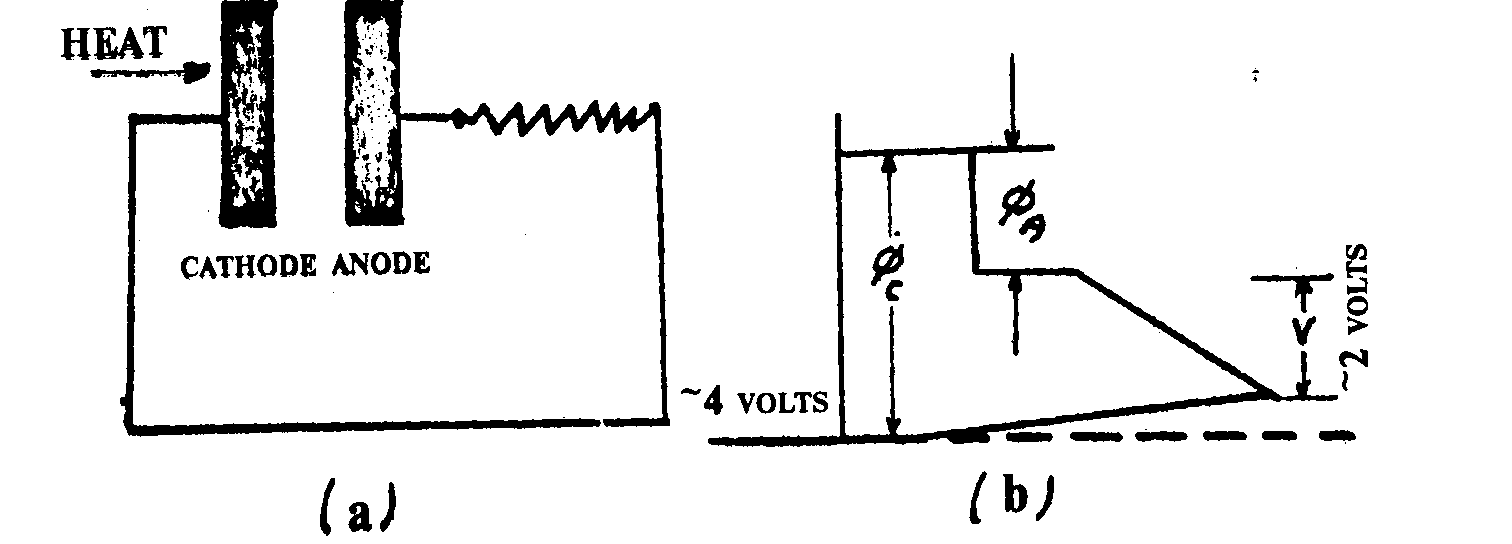
- •Reading
- •Portable generator
- •Thermoelectric Generators
- •The Basic Phenomenon
- •Principle of Operation
- •Fig.5. (a) Operating principle of a thermionic generator. (b) Potential energy diagram of electrons of the thermionic system
- •Fig.6. Plot of efficiency vs. Cathode temperature for a number of materials for thermionic generators under investigation at the Westinghouse research laboratories
Principle of Operation
Consider a plate of conductive material containing electrons that are free to move and stationary positive charges. When this cathode is heated, electrons begin to move in a random jostling fashion until a number escape from the surface of the material. Facing the cathode and separated from it in an evacuated space, is the anode; an external circuit is connected between them, Fig.5a.
As the cathode is heated, electron activity increases and electrons escape across the vacuum to the anode. The electrons then flow through the load and through the return circuit to the cathode, thus producing electric power. The concept in this simplified diagram is not new, since emission of electrons from the surface of a heated cathode is a process long used in electron tubes.
A
more quantitative picture is offered by a potential diagram that
corresponds to the schematic arrangement of the thermionic
converter, Fig.5b. Here the potential energy of the electron is
plotted at each point in the diagram. The potential inside the
cathode material is taken as zero. The electrons inside the
metal are normally prevented
from escaping by a potential barrier,![]() ,
which
exists at the surface
of the metal.
,
which
exists at the surface
of the metal.
As
the electrons become heated, a few have sufficient energy to surpass
the potential barrier and escape into the space between the cathode
and anode. When the electron reaches the anode, it falls down the
potential barrier corresponding to the anode work function,
![]() .
The energy thus released is converted into heat at the anode and is
lost in the process. If the anode work function is less than that of
the cathode, the remaining amount of energy,
.
The energy thus released is converted into heat at the anode and is
lost in the process. If the anode work function is less than that of
the cathode, the remaining amount of energy,
![]() ,
is available to do useful work in the external circuit and to
supply the electrical losses in the return circuit.
,
is available to do useful work in the external circuit and to
supply the electrical losses in the return circuit.

Fig.5. (a) Operating principle of a thermionic generator. (b) Potential energy diagram of electrons of the thermionic system
Efficiency is not the only parameter of a power converter, but is certainly among the most important, for it establishes the areas of application. To be of much practical interest, the efficiency of a power converter must be at least 10 percent. To determine the efficiency of a thermionic converter, the calculated electric power output that can be delivered to a load can be compared with the total heat input. Some of this heat goes into the useful work; some is transferred to the anode by electron motion; some leaks back through the electrical connection; and most important of all, some is transferred directly to the cold end of the machine by radiation.
The efficiency of conversion depends then on such material properties as the work function, electron emission constants and radiant emissivity, and the operating temperature. The operating temperature is, in turn, limited by the melting point or evaporation rate of the cathode. Thus material properties of the anode and cathode are important in deciding whether an efficient arrangement is practical.
The available combinations of material properties that will result in the optimum device cannot be described in a simple manner. However, Fig.6 shows some calculated efficiencies for a variety of possible cathode materials as a function of cathode temperature. These calculations, meant to be illustrative only, assume an anode reflection that gives an effective emissivity of 0.5, and an anode work function of 1.8 volts. Each curve terminates at a point where cathode evaporation becomes high enough to evaporate a millimeter of material from the cathode in 1,000 hours, a condition assumed to represent end of life.

